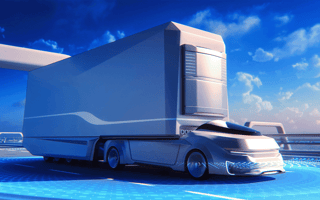Autonomous trucking is a term used to describe self-driving tractor-trailers that transport goods. The aim of autonomous trucking is to one day get big rigs and delivery trucks, and the things they carry, from point A to point B without human intervention.
What Is Autonomous Trucking?
Autonomous trucking refers to tractor-trailers that can operate without any human guidance. This is accomplished through a combination of AI technology, GPS systems and software that enable trucks to navigate highway environments on their own.
Today, autonomous trucks are traveling on roadways in various parts of the United States, like the Southwest, at a limited capacity, often with a safety driver on board to take control if anything were to go haywire.
What Is Autonomous Trucking?
Autonomous trucking is when tractor-trailers are able to operate without the need for human intervention. Relying on sensors, cameras, GPS satellites, IoT systems and AI technologies, these autonomous trucks can safely traverse highways entirely on their own.
While there are no trucks that are fully autonomous as of right now, companies are testing self-driving trucks with varying degrees of autonomy. A human driver may be positioned in an autonomous truck in case something happens, or a human-driven truck may lead a group of autonomous trucks.
How Do Autonomous Trucks Work?
Autonomous trucks work by using sensing technologies like LiDAR (a sensing technology that uses light to determine distance), radar and optical cameras to gather visual data from the surrounding area, delivering that information to a computer loaded with maps and algorithms that analyzes the information and makes decisions. It’s not too different from how a brain uses what a human eye feeds it to decide when it’s safe to change lanes or make a left turn.
Like other self-driving vehicles, software is the key to autonomous trucking. As a result, most autonomous truck companies aren’t actually manufacturing trucks, they’re writing the code that integrates artificial intelligence with all the sensors, maps, algorithms and other perception tools needed for trucks to forgo human drivers.
“We don’t build the trucks,” Alex Rodrigues, CEO and co-founder of Embark, an autonomous truck company based in San Francisco, California, told Built In. “We make software, and then we have a set of modules that we call Embark Universal Interface that allow a variety of different types of platforms to run that software.”
According to Rodrigues, Embark’s software works by breaking down the individual actions required to operate a big rig into steps related to perception, planning, control and vehicle actuation, just like a human driver would.
When Will Autonomous Trucks Be a Reality?
While autonomous trucks are a reality, they’re not the norm. Not yet, anyway.
“It was assumed that long haul trucking would be the first autonomous delivery use case to commercialize, and it since proved out that it’s somewhat more challenging than was originally expected,” Richard Steiner, head of policy and communications at Gatik, an autonomous truck company focused on middle-mile deliveries between businesses, told Built In.
But Steiner believes autonomous trucking will ultimately become more prevalent. Perhaps sooner rather than later: Aurora is set to establish a Houston-Dallas autonomous truck route in 2024, and Kodiak Robotics also aims to release its autonomous trucks this year.
Challenges and Barriers of Autonomous Trucks
A number of factors, like regulation, could impact the industry, according to Ann Campbell, a professor of business analytics at University of Iowa’s Tippie College of Business.
Getting On and Off Highways
One barrier is related to how autonomous trucks will get on and off highways and how they’ll operate in points of origin, like a port, if they’re going to be fully autonomous, Campbell said. (The most likely solution would be for a human driver to operate the truck in those situations.)
Road Conditions
LiDAR and sensors are supposed to help autonomous trucks navigate through weather like rain and fog, but their performance becomes more uncertain in extreme scenarios, like snowstorms. It’s also difficult to say how an autonomous truck would respond to an accident occurring in real time.
“I think that’s where you get the win, is when you’re on the highway and everything’s in good condition,” Campbell said. “But you still probably need what they call a safety driver, at least in some of the trucks, to handle those strange situations.”
Regulations
Additionally, there’s regulators to think about.
“At the federal level, there’s nothing that stipulates [a truck] can’t be autonomous,” Walter Grigg, industry partnerships leader at autonomous trucking company Torc Robotics, told Built In. “There are guidelines that relate to drivers and regulations that relate to drivers. And if there is not a driver, then the regulation doesn’t apply.”
But Grigg stressed that Torc is seeking a “better collective understanding” of what the expectations are around autonomous trucking.
“We’re not explicitly asking for regulation,” he said. “But there needs to be a continued distillation of thoughts and ideas into best practices and guidance. And that just comes with time.”
In the United States, more than half the states allow autonomous trucks, but some don’t, making long-haul transport difficult.
“If you’re going coast to coast, you may have to encounter a state that doesn’t allow for autonomous vehicles, so you have to go all the way around it,” Steiner said. “There’s a challenge there.”
Human Pushback
Getting consumers to trust AI remains a major hurdle, and employees in the trucking industry also have valid concerns. While autonomous trucks can help companies with driver shortages, there’s a chance the widespread adoption of autonomous trucks could leave thousands of human truck drivers jobless. If companies aren’t clear about how they plan to implement autonomous trucks, they may be hit with severe backlash from consumers and truck drivers alike.
Will Autonomous Trucks Replace Drivers?
To some degree, autonomous trucks could replace drivers, but there’s already a sizable shortage in the labor market, which is constraining the supply chain as it is. Instead, Rodrigues and others like Campbell see autonomous trucks as improving the quality of life of drivers and making the job more enjoyable.
“Being able to take out that road part and just have the drivers do the part where their technique and skill is really involved could make it a much more interesting job for people,” Campbell said.
Because Embark’s self-driving platform is designed for autonomous highway driving — not city centers — Rodrigues believes drivers will be able to work locally in a single city transporting trucks to and from highways, while Embark’s autonomous system guides the truck between those cities.
“So, you have a pool of drivers who want to be able to work in one city, but then you have a pool of actual routes that are unfilled, that are these long intercity routes,” Rodrigues said. “And what we’re able to do is pair those together, where you have the driverless truck do the ferrying across those long distances.”
Will Autonomous Trucks Replace Air Freight?
Autonomous truck companies frequently tout the benefits of self-driving trucks, from increasing efficiency in the logistics industry to cutting transport costs.
“If you look over the next decade, trucking is, fairly obviously, the market that’s going to create the most value for self-driving because it solves a really pressing problem in terms of drivers not wanting to be out on the road for long periods of time,” Rodrigues said. “In terms of moving valuable loads 24 hours a day, you get a lot more utilization and you’re solving a real problem.”
As a result, autonomous trucking has the potential to rival air freight, according to Campbell.
“This idea of going to autonomous trucking could really speed up the supply chain so much for a lot of products, that could start to make trucking be really competitive with air freight in a way we’ve never seen,” Campbell told Built In. “And that could have a big impact.”
Essentially, what would normally take several days to transport goods with a human driver, given federal regulations limiting driving time to 11 hours, could be done in as little as one day with an autonomous truck running continuously, stopping only to refuel or for inspections. As a result, companies relying on shipments could adjust the amount of inventory they receive in one shipment and could have smaller warehouses, Campbell said, all of which would reduce operating costs for businesses.
Autonomous Trucking Companies
When it comes to a driverless future in the trucking industry, these autonomous truck companies appear to be in it for the long haul.
Autonomous Truck Companies to Know
- TuSimple
- Embark
- Kodiak Robotics
- Einride
- Gatik
- Aurora
- Torc Robotics
- Waabi
TuSimple is an autonomous truck company that operates in the southern region of the United States, with its main operations being in Arizona. Currently, the company’s trucks operate with a safety driver onboard, but they come with perception technology and LiDAR sensors for added security. TuSimple’s Autonomous Freight Network focuses on a Phoenix-Tucson route, but the goal is to expand this network into Texas, Oklahoma and other southern states.
Embark designs self-driving software specifically for the trucking industry. The software is compatible with any trucking platform from all the original equipment manufacturers (OEMs), making it easy to adopt. Embark also has a plan to develop highway segments between 250 and 3,000 miles for autonomous trucks to handle. Human truck drivers would simply drop off and pick up cargo at the beginning and end of these segments.
Kodiak is an autonomous truck company that boasts an advanced trucking platform called Kodiak Driver. The platform consists of a suite of sensors, computer-controlled safety features and a simple map system that makes navigation seamless for self-driving trucks. For businesses, Kodiak also provides tracking tools, a network of autonomous trucking routes and 24/7 operations support to make autonomous trucking easier to manage.
Einride is an autonomous truck company based in Stockholm, Sweden. The company’s trucks are electric and operate in the United States and Europe. The company’s Gen 2 is designed to travel on public roads safely with cameras, sensors and night vision. Einride was the first company to be approved to operate one of its trucks without a safety driver on a public road in the United States, according to Robotics and Automation News.
Gatik seeks to make regional distribution networks more efficient with autonomous trucking. The company’s trucks use shorter, repetitive routes to limit the number of variables at play, but Gatik also conducts rigorous testing and has outfitted its trucks with Goodyear’s smart tires for good measure. Gatik can then power autonomous trucking fleets in both highway and city environments — an ability that has earned it customers like Walmart, Kroger and Tyson.
Aurora has created the Horizon trucking suite to make autonomous trucks a reality. The technology is refined through a mix of real-world data, simulations and training, and it’s meant to be easily integrated by any logistics company. Businesses use the platform to schedule loads, which are dropped off and processed at an Aurora terminal. Leveraging a system of terminals, autonomous trucks can then complete long-distance deliveries in a timely manner.
Torc Robotics is an autonomous trucking company that partnered with Daimler in 2019 after the commercial truck manufacturer purchased a majority stake in the company. Torc’s self-driving technology relies on a range of sensing technologies, namely LiDAR, radar and optical cameras. The data those sensors gather are fused together, and then behavioral algorithms are applied to essentially mimic the safety and skill of human drivers.
Headquartered in Toronto, Canada, Waabi is an autonomous truck company responsible for the Waabi Driver technology, a platform that brings advanced learning and decision-making skills to autonomous trucks. The company trains this platform in Wabi World, “the ultimate school for self-driving” that exposes Waabi Driver to common scenarios, edge cases and everything in between. Waabi also partnered with Uber Freight in 2023 to begin testing its fleet in real-world situations.
Frequently Asked Questions
When will autonomous trucks be available?
Autonomous trucks are still in development, but multiple companies — including Kodiak Robotics and Aurora — are aiming to launch autonomous trucks in 2024.
How does autonomous trucking work?
Autonomous trucking relies on LiDAR and other sensors to gather visual information and help guide autonomous trucks. IoT networks, GPS systems and AI technologies enable sensors to share this visual data and keep autonomous trucks on course throughout their journeys.
Are self-driving trucks legal?
Autonomous trucks are legal in over 20 U.S. states, and most states allow for autonomous truck testing. However, autonomous trucks must meet any state and federal regulations before officially being deployed.










